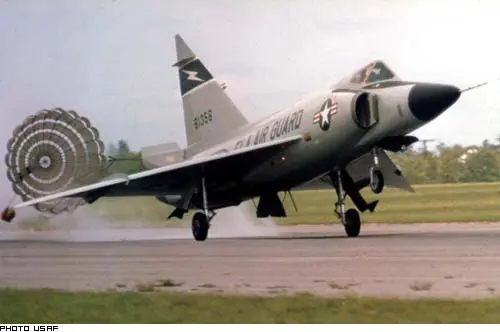Posted on October 15, 2009

During the dangerous period between the late 1950s and 1960s, the F-102A Delta Dagger was the heart of America’s Air Defense Command. If war had broken out, the U.S. SAGE network would have directed flights of Mach 1.25 F-102As to attacking Soviet bombers. Near the bombers, the “Deuces” would have taken over using their powerful on-board radars and computerized weapons control systems. They would have fired volleys of heat-seeking missiles, radar-guided missiles, unguided Mighty Mouse rockets, and even nuclear-tipped missiles. This radical interceptor was the first production aircraft with a delta wing. During its development, it pioneered aerodynamics in the transonic flight realm from Mach .8 to Mach 1.2. It was the first plane designed (actually redesigned) according to the area rule, giving it a distinctive wasp waist when viewed from above. The Deuce was America’s first supersonic interceptor. The Deuce had a long service life. First fielded in 1956, it remained in service until 1977. Although faster interceptors appeared in the 1960s, they were produced in smaller numbers than the Delta Dagger. Consequently, the F-102A remained an important part of the U.S. Air Defense System for many years longer than first planned.

Our particular F-102A flew with the Hawaii Air National Guard. In the early 1950s, a number of Air National Guard units began participating in air defense exercises under the control of regular Air Force units. In 1956, HIANG was the first Air National Guard unit to be given full responsibility for protecting a portion of America’s skies, independent of Air Force units. Only several years later were other Air National Guard units given such responsibility. During its long service, HIANG flew a stream of ever-better interceptors, including the F-86D Saber, the F-102A, the F-4F, and the F-15. It is scheduled to transition to F-22 raptors in 2010—before many regular Air Force units


